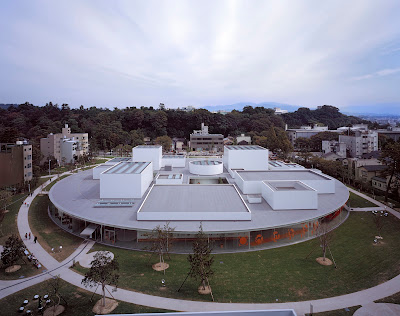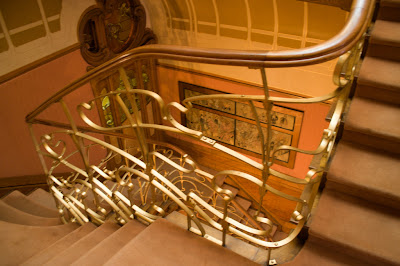The 21st Century Museum, located in Kanazawa, is one of the most important works designed by SANAA (Sejima and Nishikawa Architects and Associates). Using simple geometry and minimalist language, the project explores the permeability of the public space through different levels of transparency, a concept that these Pritzker awarded couple the has been exploiting through different approaches in previous works.
Facade of the museum. Source Wikipedia
LOCATION
The Museum of the 21st Century (1999-2004) is located in the city of Kanazawa, in Ishikawa Prefecture, located next to the Kenrokuen, one of the most beautiful and famous gardens of Japan.
The building, inscribed in a circle of 112.5 meters in diameter, is located on an irregularly shaped park.
Some of the artworks have been installed in the park, which is an extension of the museum.
CONCEPT
The museum's program includes meeting spaces, a reading room, library, workshops for children, a restaurant, service and display areas.
Therefore, the complex had to be both public and private, including free access areas for the benefit of the local population, as well as other paid
areas to allow the maintenance of this facility.
The challenge
of Kazuyo Sejima and Ryue Nishikawa was to create a balance between these two domains, blurring the boundaries between the public and private areas, and for that purpose they proposed a mixed-use layout, organized around four courtyards .

First floor
Basement
The interaction with the public space is such that at times the circulation themselves act as exhibition areas.
Only an opaque and eccentric cylinder appears as an anomaly in this rectangular gridiron layout, refering to the transparent encircling membrane of the museum.
In contrast, the outer cylinder is a thin, transparent border which is openly connected with the outside.
This is a deceptively simple but highly provocative design, that challenges the traditional notion of a museum flow, by offering visitors full freedom on their situatedness, their appropriation of space, defining their own route and their interaction with the building, art and environment.
In this context, some of the exhibited works collaborate to stress the phenomenological connection between the viewer, the displayed object and
nature, establishing not only a relationship of passive observation but of
individual and group interaction with the art.
Photo courtesy of gravestmor
Photo courtesy of aimeesoc
Another case is Vertical Green, by Patrick Blanc , a vertical garden with over 100 varieties of plants that acts as a border in one of the courtyards and which is crossed perpendicularly by a glazed circulation.
(Sorry for the quality of photos, which were secretly taken )
One the most striking is the work of Leandro Erlich, called Swimming Pool. It was unusual to find a pool in the middle of a museum, but as one approaches, it is surprising to see people underwater. Later, upon entering the exhibit areas in the basement, you may step into the pool and see people from across the "water".
The effect is very interesting and successful, affording enthusiastic public participation. It is achieved by putting two acrylic plates separated form each other by 30 cm, a space filled with water. Another layer of water about 10 cm thick has also been placed on top the acrylic to achieve a more realistic effect.
The museum has a special exhibit area in the basement, accessed by an elevator, a transparent box that is raised by a cylindrical piston, both of which in turn evoke the primary forms used in the design and refer to the concepts of lightness, permeability and simplicity that are found throughout the building.
At night, the museum emphasizes its role as urban landmark and its symbolic visual appropriation by the people of Kanazawa.
The following video shows a virtual tour throughout the Museum of the 21st Century.
SEE ALSO
- OTHER WORKS OF SANAA - ART MUSEUMS
- Hoki Museum, Chiba, Japan. Tomohiko Yamanashi (2008-10)
- Miho Museum, Shiga, Japan. I. M. Pei (1997)
- Museum of Western Art, Tokyo, Japan. Le Corbusier (1959)
- National Art Center, Tokyo, Japan. Kisho Kurokawa (2000-06)
- Suntory Art Museum, Tokyo, Japan. Kengo Kuma (2004-07)
- Watari-Um Gallery, Tokyo, Japan. Mario Botta (1985-90)






































































